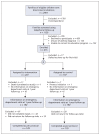Small-group, interactive education and the effect on asthma control by children and their families
- PMID: 19687105
- PMCID: PMC2734203
- DOI: 10.1503/cmaj.080947
Small-group, interactive education and the effect on asthma control by children and their families
Abstract
Background: Effective approaches to education about asthma need to be identified. We evaluated the impact on asthma control by children and their caregivers of an intervention involving small-group, interactive education about asthma.
Methods: We randomly assigned children who visited an emergency department for an exacerbation of asthma (n = 398) to either of 2 groups. Children assigned to the control group followed the usual care recommended by their primary care physician. Those assigned to the intervention group participated in a small-group, interactive program of education about asthma. We examined changes in the number of visits to the emergency department during the year after the intervention.
Results: During the year after enrolment, children in the intervention group made significantly fewer visits to the emergency department (0.45 visits per child) compared with those in the control group (0.75 visits per child) (p = 0.004). The likelihood of a child in the intervention group requiring emergency care was reduced by 38% (relative risk [RR] 0.62, 95% confidence interval CI 0.48-0.81, p = 0.004). Fewer courses of oral corticosteroids (0.63 per child) were required by children in the intervention group than by those in the control group (0.85 per child) (p = 0.006). We observed significant improvements in the symptom domain of the questionnaire on pediatric asthma quality-of-life (p = 0.03) and the activity domain of the questionnaire on caregivers' quality of life (p = 0.05). Parents of children in the intervention group missed less work because of their child's asthma after participating in the educational program (p = 0.04). No impact on hospital admissions was observed.
Interpretation: Education about asthma, especially in a small-group, interactive format, improved clinically important outcomes and overall care of children with asthma.
Figures
Comment in
-
Using education to improve control of asthma in children.CMAJ. 2009 Sep 1;181(5):248-9. doi: 10.1503/cmaj.091120. Epub 2009 Aug 17. CMAJ. 2009. PMID: 19687100 Free PMC article. No abstract available.
Similar articles
-
Internet-enabled interactive multimedia asthma education program: a randomized trial.Pediatrics. 2003 Mar;111(3):503-10. doi: 10.1542/peds.111.3.503. Pediatrics. 2003. PMID: 12612228 Clinical Trial.
-
[Impact of a small-group educational intervention for 4- to 12-year-old asthmatic children and their parents on the number of healthcare visits and quality of life].Arch Pediatr. 2013 Nov;20(11):1201-1205. doi: 10.1016/j.arcped.2013.08.021. Epub 2013 Oct 9. Arch Pediatr. 2013. PMID: 24119844 French.
-
Providing individualized written asthma action plans during the pediatric emergency department visit.J Asthma. 2021 Jun;58(6):819-824. doi: 10.1080/02770903.2020.1731824. Epub 2020 Mar 6. J Asthma. 2021. PMID: 32066290 Clinical Trial.
-
Caseworker-assigned discharge plans to prevent hospital readmission for acute exacerbations in children with chronic respiratory illness.Cochrane Database Syst Rev. 2018 Nov 2;11(11):CD012315. doi: 10.1002/14651858.CD012315.pub2. Cochrane Database Syst Rev. 2018. PMID: 30387126 Free PMC article.
-
Effects of asthma education on children's use of acute care services: a meta-analysis.Pediatrics. 2008 Mar;121(3):575-86. doi: 10.1542/peds.2007-0113. Pediatrics. 2008. PMID: 18310208 Free PMC article. Review.
Cited by
-
Using education to improve control of asthma in children.CMAJ. 2009 Sep 1;181(5):248-9. doi: 10.1503/cmaj.091120. Epub 2009 Aug 17. CMAJ. 2009. PMID: 19687100 Free PMC article. No abstract available.
-
Psychological and lifestyle risk factors for asthma exacerbations and morbidity in children.World Allergy Organ J. 2017 Oct 17;10(1):35. doi: 10.1186/s40413-017-0169-9. eCollection 2017. World Allergy Organ J. 2017. PMID: 29075362 Free PMC article. Review.
-
Effect of Orem's Self-Care Model on Perceived Stress in Adolescents with Asthma Referring the Asthma and Allergy Clinic, Isfahan, 2014.Int J Community Based Nurs Midwifery. 2016 Jul;4(3):247-55. Int J Community Based Nurs Midwifery. 2016. PMID: 27382591 Free PMC article.
-
Health care provider-delivered adherence promotion interventions: a meta-analysis.Pediatrics. 2014 Jun;133(6):e1698-707. doi: 10.1542/peds.2013-3639. Epub 2014 May 5. Pediatrics. 2014. PMID: 24799545 Free PMC article.
-
An exploration of parent-child dyadic asthma management influences on quality of life.Issues Compr Pediatr Nurs. 2015 Jun;38(2):85-104. doi: 10.3109/01460862.2015.1017668. Epub 2015 Mar 30. Issues Compr Pediatr Nurs. 2015. PMID: 25822510 Free PMC article.
References
-
- Sullivan SD, Weiss KB. Health economics of asthma and rhinitis. II. Assessing the value of interventions. J Allergy Clin Immunol. 2001;107:203–10. - PubMed
-
- National Heart, Lung and Blood Institute. Guidelines for the diagnosis and management of asthma 1997. Bethesda (MD): National Institutes of Health; 1997. Publi no. 97-4051. - PubMed
-
- Gebert N, Hümmelink R, Könning J, et al. Efficacy of a self-management program for childhood asthma — a prospective controlled study. Patient Educ Couns. 1998;35:213–20. - PubMed


